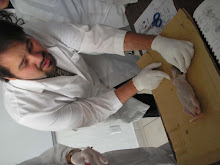In today's class we extended our knowledge in the area of organic chemistry.
-A Hydrocarbon is an organic molecule made up entirely of Hydrogen (H) and Carbon (C).
-It is also the simplest form of organic molecules.
There are two forms in which these molecules can take:
*Linear; appearance of molecule structure is "----------------" and may have branches as the image.

*Cyclic; is a molecule which has no beginning or end. appearance as so:

We continued class by looking at the subcategories of linear molecules. Which are:
-Alkanes (single bonds)
-Alkenes (double bonds)
-Alkynes (Triple bonds)
Are class continued by looking specifically at the subcategory of Alkanes. We were going to begin to combine the prefix's we had learned with hydrocarbons. We would later be able to identify and create organic molecules that where hydrocarbons, had a linear shape, and were Alkanes.
 In this molecule, we may identify 3 Carbons, and 8 Hydrogens, in a linear shaped molecule.
In this molecule, we may identify 3 Carbons, and 8 Hydrogens, in a linear shaped molecule. Its name consists in: (hydrocarbon)
3 Carbons (C) = prop as the prefix
8 Hydrogens (H) +
And as it only has single bonds it is an Alkane, meaning it ends with ane.
-----------------------------
Propane (common household gas)
Example #2

In this molecule, we may identify 6 Carbons (C), and 14 Hydrogens (H), in a linear shape molecule. Its name consists in: (hydrocarbon)
6 Carbons (C)= hex as the prefix
14 Hydrogens (H) +
And as it only has single bonds it is an Alkane, meaning it ends with ane.
------------------------------
Hexane
We continued the class by learning how to identify branches and what to call the molecule with specific branches and those that pertained to linear shaped molecules.

The process in which to discover the name of such molecule:
1) Identify the longest chain , which in this case is the 5 Carbons shaded in blue. You may identify it as pentane from this point as well.
2)then you may identify the branches but numbering 1-5 starting from the side nearest to the branch. In this case it doesn't matter what side it is as the branch is located at "3" from either side.
3)Now naming the branch comes next, you use the same prefixes for the amount of carbons in the branch. In this case it is "Meth"and as its a part of the branch it is called Methyl, only adding yl.
4)Now you may put the information you discovered as follows:
Organic Molecule: 3-Methyl Pentane
Note: you must always order the branches alphabetically!!!!!!!!!!!!!!!!
Example #3
1 2 3 4 5 6 7 8 9 10
CH3-CH2-CH2-CH-CH-CH2-CH2-CH2-
l l
CH3 CH3
1) The longest chain is 10 Carbons long, meaning it is a decane.
2)The branches are nearest to the left side of the chain. So we will number the chain for locating the branches. So the branches are located at 4 and 5.
3)Both branches are Methyl (due to one carbon in each branch).
Organic Molecule: 4,5-dimethyl-decane
Example #4
In this example it will remind you that the main chain has to be horizontal.
CH3 l
CH2
1 2 3l 2 1
CH3-CH2-C-CH2-CH3
l
CH3
1)The longest chain s 4 Carbons long, this is how it looks in a simpler form:
CH3
l
CH2
l
CH3-CH2-C-Ch2-CH3
l
CH3
It is a pentane.
2)The branches are equal distance from either side. It is located at "3"
3)In one branch it is methyl, and in the other it is bimethyl, adding them together gives you trimethyl.
the organic molecule: 3,3-trimethyl-pentane
Stefano Pinzon

No hay comentarios:
Publicar un comentario